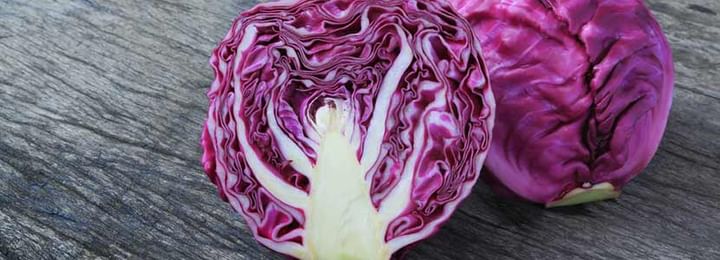Health Benefits of Red Cabbage, Uses And Its Side Effects
Last Updated: Aug 28, 2020
Red cabbage has quite a few beneficial effects as it is rich in a number of nutrients and vitamins. Consumption of cabbage helps to prevent immature aging, reduces the chances of cancer, strengthens our immune system and even helps to lose weight.
In addition to these, red cabbage intake helps to improve skin and eye health, makes your bones stronger, eliminates toxic substances from the body, prevents diabetes and also takes care of your heart. Including red cabbage in your diet may help to treat ulcers and delays the onset of Alzheimer’s disease.
About Red Cabbage
Red cabbage is also known as purple cabbage or red kraut and is a member of the Brassicaceae family. Red cabbage, like green cabbage, is round and wrapped in tightly wound waxy leaves but is distinguished by coloring, flavor and texture.
Red Cabbage can be eaten both raw and cooked and forms a delicious part of the cuisines of different countries. The primary characteristics of this vegetable are its red hue and bitter, peppery flavor.
Nutritional Value of Red Cabbage
The red colour of red cabbage is due to the presence of anthocyanin polyphenols which have anti-inflammatory properties. It also contains twice the content of Vitamin C as green cabbage. Red cabbage has minerals like manganese, potassium, magnesium, calcium and iron.
Red cabbage has ‘anti-cancer’ properties due to the presence of glucosinolates and anti-oxidants. It is rich in dietary fiber, Vitamin K, Vitamin B6 and also contains thiamine, riboflavin, retinol and folate.
Nutritional facts Per 100 Grams
Vitamins and Minerals
Health Benefits of Red Cabbage
Red Cabbage good if your facing health problems like gout and acid reflux. Add Red Cabbage in your weight management diet and diabetes patients also consume this vegetable, good for them. Read out side effects and precaution while consuming red cabbage and cultivation details also.
Red Cabbage Strengthens immune system
Red cabbage is rich in Vitamin C which is a very powerful anti-oxidant. Vitamin C catalyzes the production of white blood cells which form the first line of defense against harmful microbes.
Uncontrolled production of free radicals in our body can impair the immune system. Anti-oxidants like Vitamin C help us fight these radicals before they can do any serious damage. Vitamin C also helps in the formation of collagen which is instrumental in protecting our body tissues.
Red Cabbage helps in preventing cancer
Red cabbage is rich in anti-oxidants like anthocyanins and indoles which have amazing cancer fighting capabilities. These anti-oxidants act against the disease-causing free radicals which are actually the harmful by-products of cellular metabolism.
The indoles help to prevent breast cancer in women while Vitamin A reduces the chances of lung cancer.
Red Cabbage helps you to lose weight
Red cabbage is great to include in your diet as it will improve your calorie intake and also help you to lose weight. This is because this vegetable is low in calories and high in dietary fiber which helps to improve digestion.
Dietary fiber adds the necessary bulk to the stool and thus ensures that all unnecessary substances are eliminated. It also makes you feel fuller and prevents you from overeating.
Red Cabbage fights against arthritis
Red cabbage has phytonutrients which help to fight arthritis. This vegetable is rich in anthocyanine which helps to prevent inflammation i.e. pain and swelling in the joints which can lead to arthritis. Incorporating red cabbage in your diet will help to naturally treat arthritis and the complications associated with it.
Red Cabbage has anti-aging properties
Red cabbage has a number of anti-oxidants that act against the harmful free radicals in our body and negate the signs of aging that these free radicals may cause to occur .
The anti-oxidants present in red cabbage help to remove dark spots, reduces wrinkles and age spots and helps to keep your skin fresh and tight. Consumption of this vegetable helps to regrow skin cells, protects your skin from sun damage and retains elasticity of skin due to the abundance of Vitamin A.
Red cabbage good for your bones
Red cabbage contains minerals like calcium, magnesium, manganese and other important minerals which are essential for bone growth and maintaining mineral density.
The presence of Vitamin K in red cabbage ensures that the risks of osteoporosis in people who consume it are greatly reduced. This is because Vitamin K increases the amount of a protein which is required to maintain bone calcium.
Red cabbage takes care of your eyes
When you consume red cabbage, your body receives 33 percent of the daily requirement of Vitamin A. This vitamin is delivered in 3 different forms like beta-carotene, lutein and zeaxanthin. Beta-carotene is converted into retinol, a form of Vitamin A, and this helps eye cells to detect light and convert it into nerve impulses. Vitamin A also helps to prevent macular degeneration and formation of cataracts.
Red cabbage helps treat ulcers
The presence of a particular amino acid called glutamine in red cabbage is responsible for its beneficial effects in reducing pain and inflammation associated with ulcers. Incorporating red cabbage in your diet is the best way to treat ulcers naturally.
Red cabbage helps to prevent Alzheimer’s disease
Red cabbage can protect the cognitive ability of people and hence helps to prevent or at least delay the onset of chronic diseases like Alzheimer’s disease. Memory loss occurs due to the formation of a certain type of plaque. The anthocyanins in red cabbage help prevent Alzheimer’s by preventing the occurrence of this plaque and thus protect your brain.
Uses of Red Cabbage
Red cabbage has a number of nutrients and vitamins and it can be consumed in a number of ways. It contains the highest nutrition when it is raw. The nutritional benefits start to reduce when the vegetable is heated. In Europe and in the United States red cabbages are often pickled raw and made into sauerkraut.
Red Cabbage vegetable is a pertinent part of the cuisine of many countries and it can be had with grilled meat, olive oil, butter, eggs and cheeses and even avocados and chillies.
Red Cabbage is often used as a pH indicator as it changes its colour according to the material on which it is. It lasts longer than traditional cabbages and thus saves you the hassle of consuming it immediately.
Side-Effects & Allergies of Red Cabbage
Red cabbage should be avoided by pregnant and breastfeeding women as its effects are not well known in such cases. Nursing infants can develop colic if the mothers even sparingly consume red cabbage.
Hypothyroidism is a condition which develops when the thyroid gland under performs. This condition can get deteriorated if the person suffering from such consumes red cabbage. Furthermore, diabetic people should check their consumption of this vegetable as it affects the blood sugar level in diabetics.
Cultivation of Red Cabbage
The origin of red cabbage, as with all varieties of cabbage, can be traced back to Europe. It is believed that Celtic wanderers brought wild cabbages to Europe in around 600 B.C. The Nordic and Celtic tribes created the hard-heading cabbages in Europe.
Although the Romans introduced Europe to red cabbage in the 14th century, the first description of this vegetable can be found in England in 1570. It was considered a part of aristocratic culinary in the 18th century. It is, at present, grown and eaten throughout the world.
Red cabbage requires full sun and they should be planted at a distance of 18-24 inches depending on the variety. Well-drained and nutrient-rich soil which is high in organic matter is essential. The soil should be kept moist throughout the growing season. The vegetable can withstand hard frosts and should be harvested when the heads appear firm. The heads should be cut from the base of the plant.
References
- Draghici GA, Alexandra LM, Aurica–Breica B, Nica D, Alda S, Liana A, Gogoasa I, Gergen I, Despina-Maria B. Red cabbage, millennium’s functional food. JOURNAL of Horticulture, Forestry and Biotechnology. 2013;17(4):52-5. [Cited 26 June 2019]. Available from:
- Hafidh RR, Abdulamir AS, Bakar FA, Jalilian FA, Jahanshiri F, Abas F, Sekawi Z. Novel anticancer activity and anticancer mechanisms of Brassica oleracea L. var. capitata f. rubra. European Journal of Integrative Medicine. 2013 Oct 1;5(5):450-64. [Cited 26 June 2019]. Available from:
- Chandrasenan P, Anjumol VM, Neethu MV, Selvaraj R, Anandan V, Jacob GM. Cytoprotective and antiinflammatory effect of polyphenolic fraction from Red cabbage (Brassica oleracea Linn var. capitata f rubra) in experimentally induced ulcerative colitis. J Appl Pharm Sci. 2016 Jan;6(1):137-46. [Cited 26 June 2019]. Available from:
Table of content
Ask a free question
Get FREE multiple opinions from Doctors



